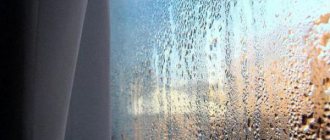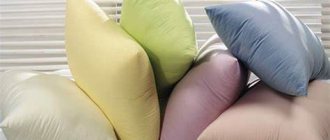High humidity and a feeling of dampness are the scourge of not only private houses, but also city apartments. Even apartments located in modern luxury new buildings very often suffer from high humidity: the favorite place for mold fungi is the lower part of the walls.
A completely logical question arises - what to do in order to prevent such an undesirable phenomenon, ensure a decrease in air humidity in the room and not encounter such a problem in the future.
To answer it, it is necessary to understand the reasons causing the increase in humidity and, if possible, try to reduce their influence.
How to measure humidity level?
Maybe it just seemed to you that the air in the apartment is normal? Does your skin dry out due to improper care? To find out for sure, you need to measure the humidity level in the room. This is not difficult to do, there are even several ways:
- use a household hygrometer. This is a simple device that quite accurately and quickly determines the level of humidity. It costs literally pennies, so anyone can afford it;
- a home weather station is, one might say, a more advanced version of a hygrometer. Some models are also very affordable, but at the same time they show the temperature, can also detect pressure and use special icons to notify whether the microclimate in the apartment is comfortable;
- will do and regular glass of water, however, it will only allow you to judge whether there is a lot of moisture or little, but will not give the exact percentage of humidity. It is necessary to put a glass of water in the refrigerator for a couple of hours so that the liquid cools to 3-50C, then put the glass in the room (preferably away from the battery for the purity of the experiment) and observe. After a couple of minutes, condensation forms on the outer walls, and if it dries out over the next 5-10 minutes, then the air is dry, if it remains, everything is fine, and if it starts to drain, then the humidity is excessive;
- There is an option to use a fir cone . Let it lie in the room for a while, then watch the scales. If they have fully opened, then most likely the air in the apartment is too dry. The cone must be fresh.
Many other things indicate low moisture levels . For example, hanging laundry dries very quickly, or water in a saucer evaporates almost instantly. The problem will also be indicated by the overdried tips of the plants and, of course, your feelings. These include dry throat and eyes, a feeling of tight and dry skin, brittle, electrified hair, cough, headaches, and fatigue.
If there is still a problem with dry air, then it is better to find a solution as soon as possible. The easiest and most expensive way is to buy a humidifier, fortunately, there are a lot of them in stores. We will consider this option, but first let's try to make do with available methods.
Microclimate standards
Breathing dry air is harmful to health, so there are ways to humidify it without special devices.
Currently, in Russia, the main regulatory document regulating the design, construction and maintenance of premises is SP (Code of Rules) 60.13330.2016. It is called: “Heating, ventilation and air conditioning." The text provides definitions of optimal and acceptable air quality for residential and industrial buildings.
With optimal parameters, the person in the room is comfortable and there are no health hazards.
Acceptable characteristics determine the qualities under which a person will remain healthy, but the feeling of being in an apartment or private house will not be pleasant.
Quantitative values are specified in GOST 30494-2011. “Residential and public buildings. Indoor microclimate parameters."
To the critical parameters of clause 4.2. GOST include:
- temperature;
- air flow speed;
- relative humidity.
The table shows the exact characteristics for various premises.
| Purpose of the premises | Temperature, ºС | Relative humidity, % | ||
| Optimal | Acceptable | Optimal | Acceptable | |
| Living room | 20 – 22 | 20 – 24 | 45 – 30 | 60 |
| Kitchen, toilet | 19 – 21 | 18 – 26 | No norm | No norm |
| Rooms for study and relaxation | 20 – 22 | 20 – 24 | 45 – 30 | 60 |
The humidity level for storerooms, bathrooms, and lobbies is not standardized. The characteristics are applicable only for rooms with long-term (more than 2 hours) continuous occupancy of people.
In summer, you can often ventilate the room.
In summer, the microclimate is standardized only for living rooms:
- optimal temperature – 22 – 25 ºС;
- permissible - 20 – 28 ºС;
- optimal relative humidity - 60 - 30%;
- acceptable - 65%.
If temperature affects a person’s well-being and sense of comfort, deviations in the moisture content in the air entail dangerous consequences for health.
No. 1. Dry clothes in the room
If you previously hung your laundry on the balcony or left it to dry in the bathroom, then try hanging it in the room. Evaporating moisture will instantly increase the humidity level in the apartment, and you don’t even have to do anything special for this.
A drying rack with an abundance of hanging things in the living room or bedroom is, of course, not the best interior decoration, and for some, such a sight may even infuriate them. If you are one of them, try leaving your laundry on only overnight. Repeated moisture measurements will tell you how effective the method is in your case.
Advice - it is better to place the dryer closer to the radiator.
The harm of dry air
In most regions of the country in winter, when the heating is turned on, the humidity in the rooms decreases - the figure is in the range of 18 - 25%. With prolonged daily exposure to such conditions, many human biological systems suffer.
General health
Children and elderly people in dry rooms are more likely to get colds.
Doctors note that when humidity is below normal, fatigue quickly sets in, muscle tone decreases, and the immune system can no longer cope with pathogens.
An unacceptable microclimate causes the greatest harm to children, elderly apartment residents and people with respiratory diseases.
Eyes
Under normal conditions, the surface of the eyes is covered with a thin layer of tears, which washes away trapped dust particles and pathogens.
In a dry room, tears dry out quickly - the protection is reduced, which leads to irritation of the cornea, and “dry eye” syndrome appears.
Respiratory system
The mucous membranes of the respiratory tract and bronchi must always be kept moist for self-cleaning. This prevents infections from entering the body.
Winter indoor air dries out the surface of the nasopharynx and bronchi, which reduces the body's defenses. Dry mucous membranes can lead to nosebleeds.
Skin and hair
Low humidity is harmful to the skin
Low humidity in the room has a detrimental effect on the health of the skin. The greatest harm occurs to exposed parts of the body: the face and hands. Microcracks appear on the surface, which opens the way for infections. Inflammation and irritation appear.
Lack of moisture negatively affects hair, making it brittle and dull. It is in winter that many people experience a worsening problem with dandruff.
Newborn room
The newborn's room requires special attention.
The mechanisms of thermoregulation and adaptation to the microclimate in a child are not yet configured to work properly. The responsibility to adapt to environmental conditions lies with the baby’s parents.
The microclimate parameters in the room with the newborn must be maintained throughout the day—there should be no sudden changes.
To accurately measure temperature and humidity, you need to purchase thermometers-hygrometers. The price of a digital device does not exceed 80 - 100 rubles.
No. 2. Towels and bottles on the radiator
A simple folk method is to hang a damp towel on the radiator . The advice is effective, but you will have to change or re-wet the towel very often, because resourceful housewives once came up with the idea of dipping the tip of a towel/gauze/cotton fabric into a plastic bottle suspended from the radiator, in which they made a hole in the wall and poured water into it.
Another option is to simply hang a few water bottles behind the radiator . To ensure that the evaporation area is sufficient, it is better to make a hole in the wall rather than just unscrew the lid. The bottle can be decorated.
A more modern way is special humidifiers for the battery . The principle of operation is the same as that of simple bottles, but it will all look prettier. Such humidifiers are also filled with water, which then evaporates naturally; only the devices themselves are made of ceramics, steel, plastic and other materials. They can have almost any shape and color, so they will fit well into the interior, becoming its unusual decoration. Guests who are not in the know may not understand at all that this is a humidifier and not decor.
Tip – you will most likely need several bottles or humidifiers to speed up the hydration process.
Which humidifier is most effective and which is not?
To increase the humidity in the room, use available products. This is especially true during the heating season.
- Leave a basin or wide bowl of water near heating appliances. Hot air will evaporate water, humidifying the climate.
- Hang wet laundry on the radiators or install dryers nearby. This method will help reduce the temperature and increase the humidity.
- Buy an aquarium, the water in it will gradually evaporate and saturate the dry air with moisture.
- Install an artificial fountain in the room. It will perform not only a decorative function, but also moisturize the air masses.
- Get some indoor plants. They saturate the air with oxygen and release some moisture. When watering and spraying, moisture also occurs.
We recommend another useful article about air conditioner malfunctions and how to fix them. And here you can read about which bathroom exhaust fan is best to choose. Another useful material about how to quickly and easily clean the hood in the kitchen.
No. 3. Water containers throughout the apartment
Another simple option for natural hydration. If now you have imagined buckets and basins of water throughout the apartment, and have already become desperate, then we hasten to tell you a nicer and no less effective option for organizing humidification of this kind.
A beautiful vase in a minimalist style can serve as a container . These are often used as interior decoration, so if you add another function, no one will notice. The main thing is that no one knocks over the vase. Water can be poured into a transparent container; an aquarium will do. It is not necessary to have fish (but if you want and are not afraid of care, why not), and you can decorate the container with beautiful stones, decorative algae, shells or houses - all this stuff is sold in the same place where aquariums with fish are sold. Just remember to change the water and wash the containers occasionally.
An aquarium or indoor fountain will also increase humidity.
Ways to humidify air without a humidifier
The easiest and most reliable way to humidify the air is to purchase a special climate control device called a humidifier. This device allows you to increase the humidity to the specified parameters, thanks to which you can avoid the formation of dampness in the room due to too intense and prolonged humidification with improvised means.
Special climate technology can not only regulate air humidity, but also its temperature, cleanse it of unwanted impurities, and enrich it with substances beneficial to health.
Since such devices are not cheap, you can save money and try to restore the microclimate in the room in other ways.
Ventilation
This method is the simplest, but it is recommended to combine it with other methods.
It must be remembered that ventilating the room in winter, in severe frost, will not only not help increase the humidity level, but will also cause the air in the room to become even drier. This is explained by the fact that at temperatures below 0 ˚C, absolute humidity is very low. When frosty air enters a warm room from the street, it heats up, which leads to a decrease in relative humidity.
But in summer, autumn and spring, ventilation can be used, since the atmosphere contains a sufficient amount of moisture.
Note: It is especially effective to ventilate the apartment with dry air in rainy weather or heavy fog.
Wet cleaning
To achieve tangible results, it is recommended to carry out wet cleaning daily. After washing the floors and wiping the furniture, the moisture begins to evaporate, which increases the humidity in the apartment.
In addition, dry air leads to increased dust formation and the proliferation of harmful microorganisms that live in dust - mites. Frequent wet cleaning will help not only normalize the microclimate, but also destroy a significant part of microbes and reduce the amount of dust.
Tip: If the floors in the apartment have carpets, then the best option for wet cleaning in this case would be a washing vacuum cleaner. You can also use it to clean chairs, sofas, and mattresses.
Aquarium or fountain
An aquarium can become not only an excellent decorative decoration for your home, but also an additional source of moisture.
Modern aquarium models are available with lids that prevent moisture evaporation and debris from entering the tank. If the air in the apartment is too dry, the cover will need to be removed. Since the amount of liquid will constantly decrease with intense evaporation, you will have to periodically add clean water to the aquarium.
Another effective method of humidifying dry air in a home is installing a decorative fountain. The murmur of water has a beneficial effect on the psycho-emotional state of people living in the house, relaxing and calming. The only drawback to using an indoor fountain is the need for periodic cleaning and water replacement.
Houseplants
Plants help humidify and ionize the air, so to eliminate the problem in question, you can start a flower garden at home. It can be placed on window sills or special racks. The more indoor flowers there are in the apartment, the more noticeable the moisturizing effect will be.
In addition, the water evaporating from the pots during watering will also provide additional saturation of the air with moisture. Several indoor trees growing in large-diameter pots can give good results. Of course, most indoor trees are significantly more expensive compared to small flowers, such as Saintpaulias or cacti, but this is not a reason to refuse to grow them.
If you don’t have the money to buy indoor trees, you can grow several lemons, oranges or tangerines from seeds. The process of growing them will take at least 3-4 years, but during this time the air in the apartment will be saturated with moisture due to the evaporation of moisture from the large pots in which citrus fruits grow.
The flower garden in the house is also good because indoor plants require regular spraying. Frequently misting the room is another great way to combat dry air.
Tip: If you have no desire or opportunity to grow flowers, you can simply spray clean water from a spray bottle in the house several times a day.
Drying clothes in the room
One of the most effective methods for significantly increasing air humidity is drying clothes indoors. If the hygrometer shows too low values, then after washing it is recommended to hang things not on the balcony or street, but directly in the house.
In winter, they can be placed on a radiator, and in summer - on a special dryer. If there is no such dryer, then the laundry is hung on interior doors, radiators, chairs and other suitable surfaces. If desired, you can string a rope in the kitchen and bathroom.
Linen hung throughout the apartment creates an unaesthetic appearance and interferes with free movement, use of chairs, and closing doors. Although this method does help increase humidity levels by 15-30%, it may not be acceptable for many.
Boiling
When preparing compotes and first courses, you can resort to a little trick - do not close the lid of the pan. Although this will cause the liquid to boil more slowly, the water that evaporates during cooking will help increase the humidity level in the room.
When cooking in the oven, the air in the room becomes even drier. To avoid this, it is better to steam dishes. Cutlets, meatballs or fish prepared in this way contain fewer calories and are healthier.
To restore a normal microclimate, you can simply put a pan of water on the stove, bring to a boil and turn on low heat. During the boiling process, the liquid will evaporate and saturate the room with moisture. You can add orange or lemon peels, mint or cinnamon to boiling water, which will fill your home with a pleasant aroma. It should be taken into account that too frequent use of the boiling method can lead to peeling of veneered facades, trim, and wallpaper.
Water containers
If you don’t want to boil water, you can simply place containers of water throughout the house. It will evaporate and release moisture to the external environment. The larger the area of the container used, the more moisture will evaporate.
There are special ceramic containers with a flat back surface and a loop for hanging on a radiator. Such devices do not spoil the aesthetic appearance of the room, do not take up space, do not interfere, and at the same time perform their function perfectly.
In the absence of special ceramic humidifiers, you can make them yourself. To do this, you will need to attach several plastic bottles with the neck cut off to each radiator and fill them with water.
Bowls with hydrogel
Hydrogel balls can be used not only for growing flowers, but also as a means of humidifying the air in the house. 10 g of colored polymer balls absorb up to 2 liters of water. They can be placed in glass vases, filled with water and placed throughout the house. You will need to periodically add water to the vases as it evaporates.
Homemade humidifier
A homemade battery humidifier is one of the easiest models to make. The structure consists of the following elements:
- plastic bottle or jar with a volume of 5-6 liters;
- two pieces of wire;
- long wide bandage.
Using a stationery knife or sharp scissors, cut out a rectangular window in the eggplant. Then, wrapping the container with wire around the neck and the lower part located near the bottom, attach it to the heating pipe.
Now all that remains is to fill the bottle with water, cut off 2 m of bandage, fold it in half along its entire length, and lower the middle part of the resulting tape into the water through the window made in the bottle. Both ends of the bandage need to be wrapped around the pipe, and your homemade humidification system is ready.
Conclusion
If you suspect that the air in your apartment is too dry, it is first recommended to purchase a hygrometer and measure the humidity. If the device shows too low values, then it is time to take measures to restore the normal microclimate in the house.
Each of the methods described above can only slightly increase the percentage of humidity in the room, and in order to understand how effective a particular method is, while using it, you should record the hygrometer readings and draw appropriate conclusions to adjust the humidity.
So, after washing the floors, the humidity increases by about 5%, and to increase the indicator by 10%, you will need to hang about 4-5 kg of wet laundry in the room.
No. 4. Open door to the bathroom
We all know that the main problem in the bathroom is high humidity. Because, as they said in one Soviet film, “those who hinder us will help us.” After bath procedures, leave the bathroom door open - let all the moisture, and there will be enough of it, go into the apartment. It turns out to be very effective - at the level of an air humidifier.
You can even leave the bath in there for a while, because this is a huge container of water that will work to our advantage. Some even advise not to turn on the ventilation in the bathroom so that more moisture accumulates. If possible, then you can take a bath or shower with the door open - let the moisture not stagnate and immediately go out into the apartment.
Why is the air in the apartment dry?
In the warm season, there is no need to worry about humidity in your home; an increased amount of water in the air leads to discomfort.
In winter, the indicator drops sharply and usually in city apartments does not exceed 20 - 25%, which is lower than the indicators required by GOST.
Hot batteries are often cited as the cause. Actually this is not true. The table shows how much water vapor is contained in the air at different temperatures and different humidity levels.
Forced ventilation increases air humidity
All apartment buildings are equipped with ventilation systems, which ensure multiple changes of air in the room - dirty air is removed through the ventilation system, new air comes in from the street during ventilation, through window supply valves, gaps in doors and window frames.
For example, at a room temperature of 20 ºС, according to standards, there should be an average of 5 to 8 degrees in the air. water.
Typical winter indicators, for example, at minus 15 degrees - 80% humidity. Therefore, the air contains only 1.1 grams. moisture.
Street air, entering the room for ventilation and mixing with room air, sharply reduces the humidity level. The process occurs continuously throughout the cold months.
No. 6. Wet cleaning
Well, what would we do without her! Wet cleaning is a real salvation both in the heat, and in the struggle for clean air, and in efforts to increase the level of humidity. True, this measure alone cannot provide more than 2-3% humidity, and it requires time from you, but in combination with other measures it will work well.
Working principle of a dehumidifier
1. Air from the room enters the cold evaporator, where the air gives off excess moisture (as you know, cold air retains moisture worse).
2. Excess moisture (condensation) flows into the pan or is removed using a drainage tube to the outside.
3. The cooled and dried air enters the warm condenser, where it is heated to the previous temperature.
4. Dry air is supplied back into the room.
The most modern are condensation type dehumidifiers, whose design is similar to the design of a household air conditioner.
The air is not cooled when the dehumidifier is operating.
No. 7. Cook more - bake less
You've probably noticed that when the kettle boils or something cooks on the stove for a long time, many surfaces in the kitchen become covered with condensation. Here it is - a free source of moisture: you cook, and at the same time you increase the humidity.
Instead of baking in the oven, try boiling or steaming more. After boiling, you can keep the kettle on the burner for a short time, using the minimum heat level - let the moisture vapor spread at least throughout the kitchen.
You can boil a large pot of water and then leave it open so that the hot steam gradually evaporates. You can add eucalyptus or tea tree essential oil to the water - they have a pleasant aroma and kill pathogens. You can add cinnamon sticks or orange peels. The most practical ones will add dumplings to boiling water and also get a hearty lunch. When you take out the finished dumplings, do not forget to leave the pan open.
Open the door from the kitchen wider, let the humid air spread throughout the apartment along with the aromas of food. The main thing is that the surfaces near the stove in the kitchen can withstand steam and condensation.
What are the consequences of exceeding the norm for indoor humidity?
Yandex.Pictures
Optimal humidity does not harm human health. The main danger even for healthy people is the appearance of harmful bacteria and microorganisms. Where it is warm and humid, colonies of fungi and mold form, the spores of which lead to allergies and asthma.
If you ignore deviations:
- Respiratory diseases will become more frequent. Diseases will take on a more severe form. Residents are at risk of bronchitis. And when, against the background of allergic and asthmatic manifestations, the disease takes a chronic form, it is extremely difficult to cure it.
- Difficulty breathing causes decreased tone. The result is a lack of performance, muscle spasms, and insufficient activity of the cerebral cortex. Attacks of suffocation interfere with sleep, which leads to fatigue.
- Unpleasant odors eat into furniture, clothes, and hair, and you won’t be able to get rid of them as long as the humidity is higher than normal. The reason for this is the results of the action of bacteria, fungal spores, mold decomposition, etc.
Yandex.Pictures
After washing, things take a long time to dry, which further aggravates the situation. Contacts and microcircuits of household electrical appliances oxidize. The TV, computer, washing machine fails, and such a case is not covered by warranty. Damp furniture becomes deformed, creaks, and cracks. Fabric upholstery, mattress, pillow, blanket takes on an unpleasant odor.
No. 9. More indoor plants
Everything is simple here. Plants need to be constantly watered, and some of them themselves provide good air humidification. These are ficus, hibiscus, dracaena, fatsia, nephrolepis or house fern, parmania or indoor linden, tradescantia, chlorophytum. You can place several small plants on the windowsill or a whole palm tree in the corner of the room. Both beautiful and practical.
Household premises
| Place | Frequently encountered problems | Possible Solution |
| Apartment | Rapid spoilage of food, poor health, damaged furniture, parquet flooring, mold on the walls, ceiling, risk of short circuits, expensive repairs | Regular use of a dehumidifier (10-50 l/day) |
| Bathroom | Mold on walls, ceilings and interior items, long drying times for clothes, risk of short circuits | Regular use of a dehumidifier (10-50 l/day) |
| Pantry | Spoiled food, mold | Regular use of a dehumidifier (10-50 l/day) |
| Garage | Corrosion of tools and metal structures, corrosion of the car body, mold, poor health, expensive car repairs | Regular use of a dehumidifier (20-50 l/day) |
| Cellar/vegetable storage | Spread of parasites, rapid rotting of food, mold on walls, drawers and shelves, losses from spoiled food | Regular use of a dehumidifier (20-50 l/day) |
| Dacha/country house | Mold on walls, furniture, ceilings, risk of short circuits, spoiled food, poor health, damaged wood and metal structures, parquet, expensive repairs | Using a dehumidifier (20-50 l/day) in the off-season (spring, autumn). Depending on the climatic conditions, more frequent use possible |
| Saina, swimming pool | Damaged wooden and metal structures, mold, failure of wiring and electrical equipment | Regular use of a dehumidifier (30-50 l/day) |
No. 10. Aqua soil
These are colored balls that are actively used in gardening. They can quickly absorb water and then evaporate it. That's what we need. It is worth pouring the aqua soil into containers and placing it around the apartment. Since the balls are colored, they will not only moisturize, but also decorate the room. They need to be watered once and then stirred occasionally so that all layers of the substance release moisture back. Sometimes it is worth adding water.
In the house
Often, owners of country houses and private cottages discover that the air humidity inside their homes is too high. Solving the problem is not difficult, you just need to check the operation of some systems and, if necessary, install additional equipment.
We recommend that you read: Making a household air recuperator with your own hands
What is recommended to do to control the microclimate in the house:
- In spring and summer, ventilate the cottage more often.
- In winter, install a heating radiator.
- Equip the kitchen with a hood, which is a good helper in the fight against unpleasant odors, and its operation also provides a flow of fresh air.
- Regularly clean the ventilation from accumulated dust.
- Buy indoor plants for your home that do not require frequent watering, for example, cacti.
- Check the serviceability of the sewer pipes and find out if there is a leak.
- Dry washed clothes on the balcony or loggia.
If your home is undergoing cosmetic renovations, you should give preference only to natural finishing materials. They absorb evaporating moisture better and dry out faster.
Another way to reduce air humidity is to purchase absorbent products. Their job is to absorb excess moisture. The products are sold in construction and hardware stores.
Microclimate depending on the type of premises
It is believed that the required air humidity in an apartment for a person depends on the purpose of a particular room. What level of humidity can be considered comfortable for bedrooms, kitchen, bathroom, living room, dining room, office? It turns out that the requirements for the microclimate of different rooms may differ. To shed light on the issue in more detail, let’s consider the features of the humidity regime for each category of premises.
Children's room
If the normal air humidity in the apartment is within 30-45% in winter and up to 60% in summer, a more strict regime is recommended in the children's room - 50-60%, regardless of the time of year. You need to know that the indicated parameters are calculated for a certain temperature - 22-24º C. In the case of a child’s colds, flu or acute respiratory infections, it is recommended to increase the humidity in the nursery to 65-70%. This is necessary to prevent drying out of the mucous membrane, ease breathing and for a number of other reasons:
- Dry air negatively affects the condition of the respiratory tract, brain activity, skin condition, and causes redness of the membranes of the eyes;
- The skin begins to peel, the mucous membrane of the nasopharynx becomes irritated, and breathing becomes difficult;
- General health worsens, problems with concentration arise. Such a child is characterized by excessive irritability and fatigue.
Children generally tolerate dry air more difficult than adults. If you regularly stay in a dry atmosphere, you may develop an allergy to dust, and the risk of chronic bronchitis or asthma increases. Humidity should be controlled especially carefully if there is an infant in the room. Due to dry air, the newborn's vital resources will be wasted on sweat production at the expense of internal fluid resources.
Adults' bedroom
The optimal level of humidity in a bedroom for healthy sleep and relaxation is determined by GOST and should be at the level of 40-55%. Under special climatic conditions, higher air humidity in the apartment is allowed, up to 70%, but it is not recommended to lower the bar below forty percent. A sure way to not only meet the standard, but also strengthen your immune system is to sleep with the window open. We just need to make sure that the environment outside the window allows us to do this without risk to health. Otherwise, a ventilator equipped with a stepped filtration system will help out.
The room should be ventilated not only in summer, but also in the cold season. How to let frosty air into your apartment without catching a cold? To avoid hypothermia, a breather is placed in the bedroom, heating the air supply to comfortable values.
A decrease in humidity below the proper norm creates a less than comfortable atmosphere in the room, incompatible with sound and healthy sleep.
Important points:
- Do not overload the sleeping area with household appliances, their presence will negatively affect the quality of the air, and therefore healthy sleep;
- When assessing the humidity level in your bedroom, make allowances for temperature conditions. The comfort temperature for which the standards were calculated is in the range of 22-24º C. In the bedroom, even lower parameters are recommended for proper rest - up to 16-18º C. Standard humidity can turn an overheated room into real tropics.
Kitchen and bathroom
The specific atmosphere of these two rooms depends on the current moment. Now it's dry, but ten minutes later it becomes very humid. Therefore, the humidity level for them is not standardized either by construction standards or sanitary standards. As a rule, there are exhaust ducts in the kitchen and bathroom that draw air from the bedrooms. Therefore, too low air humidity in the apartment naturally and beneficially affects the concentration of water vapor in these rooms. But when the kitchen and bath are used for their intended purpose, a boiling pan, a kettle, or a shower head can instantly change the situation and bring the relative humidity to a critical 90 and even 100%.
Excess moisture creates ideal conditions for the occurrence of pockets of dampness. Fungus can settle in damp rooms and dust mites can actively multiply, causing concern to asthmatics. The best way to resist dampness in the kitchen and bathroom:
- Install an exhaust hood over the kitchen stove and use it more often;
- An exhaust fan installed in place of the natural exhaust grille can normalize the bathroom microclimate.
By adjusting the exhaust functionality of wet rooms, you can forget about problems with dampness in the kitchen and bathroom.
Living and dining room
Rooms such as a living room or dining room are more common in manor house designs. But today they are included in the layout of respectable luxury apartments and are subject to current relative humidity standards. It is considered normal for a living room or dining room to have moderate humidity between 40 and 60%. This level of humidity is favorable for owners and pets. By maintaining a stable humidity regime, we provide good conditions for the preservation of furniture and finishing materials. During the heating season, with a decrease in humidity, the risk of respiratory diseases increases. The question arises of how to increase the air humidity in an apartment without creating conditions for the formation of rot and mold. What can you do to bring the humidity level of your dining room or living room up to normal?
- Put an aquarium there. It is not at all necessary to keep fish in it that will require care. Place ornamental plants and shells in a glass tank filled with water. They are not demanding to maintain and will decorate the interior;
- Buy indoor flowers, remembering to spray them often;
- Use a humidifier, they are in particular demand during a pandemic;
- Wet clean the apartment a couple of times a week;
- Regularly hang damp cloths over the batteries. Although this method is labor-intensive, it really helps.
Study
Is it possible to set up a work office in an apartment to do business there? Self-employed and individual entrepreneurs often follow this path, thus saving on office maintenance. If your apartment is on the ground floor, it is even possible to make a separate entrance from the street, having received the consent of the municipal architecture. But not everything is as simple for private business as it seems at first glance. No one will come to check the air humidity levels in the apartment, and an inspector from Rospotrebnadzor or a representative of the labor inspectorate may come to the entrepreneur’s office to check.
They can check if your work area's humidity levels are within guidelines. The workroom standard is determined by GOST 30494 and SanPiN 2.2.4.3359. According to the standards, the humidity of office premises should not exceed the parameters of 40-60%. The mentioned documents have the force of law. Failure to comply with the microclimate standard may result in administrative penalties and fines. But entrepreneurs have a great way out of this situation. To maintain the standard humidity in your office, it is often enough to buy a humidifier.











